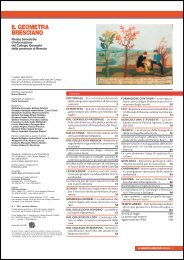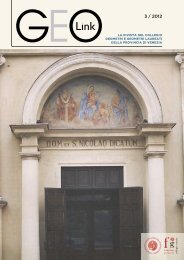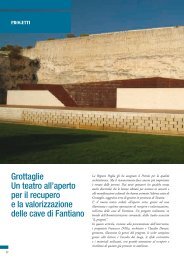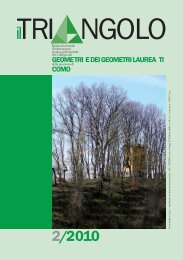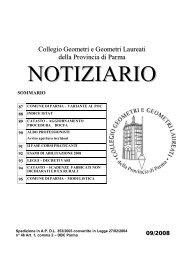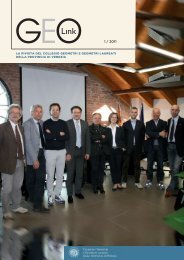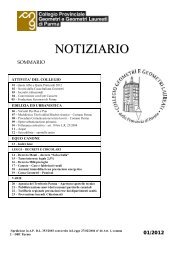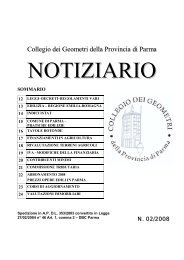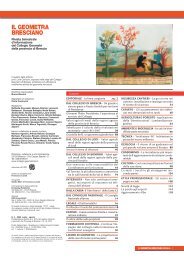Nox, l'architettura come punto d'incontro fra natura e tecnologie digitali
Nox, l'architettura come punto d'incontro fra natura e tecnologie digitali
Nox, l'architettura come punto d'incontro fra natura e tecnologie digitali
Create successful ePaper yourself
Turn your PDF publications into a flip-book with our unique Google optimized e-Paper software.
ESTERO<strong>Nox</strong>, l’architettura<strong>come</strong> <strong>punto</strong>d’incontro<strong>fra</strong> <strong>natura</strong>e <strong>tecnologie</strong> <strong>digitali</strong>Le loro opere sono esposte in alcuni <strong>fra</strong> i principali musei d’arte<strong>come</strong> il Centre George Pompidou di Parigi, il MOMA diNew York e il Victoria & Albert di Londra. Hanno progettatoedifici avveniristici ed installazioni che sono entrate a far partedel paesaggio urbano di città e metropoli del mondo.Stiamo parlando dello Studio <strong>Nox</strong>, un gruppo diprogettisti olandesi con base a Rotterdam considerati tragli sperimentatori più arditi di quell’‘area’ dell’architetturacontemporanea che spesso si fonde con l’arte e si sviluppa inun rapporto di contaminazione ed imitazione con la <strong>natura</strong>da una parte e le nuove <strong>tecnologie</strong> <strong>digitali</strong> dall’altra.Fondatore e leader del gruppo è Lars Spuybroek, cinquant’anni,dichiaratamente insofferente verso le limitate possibilità disviluppo dell’architettura, “imprigionata nei confini che essastessa si era creata negli ultimi decenni” e per questo impegnatoin un percorso di cosiddetta ‘ibridazione’. Nell’attività delloHtwoOexpoTheir works are exhibited in some of the major art museumssuch as the George Pompidou Centre in Paris, the MOMA inNew York and the Victoria & Albert in London. Futuristicdesigned buildings and facilities that have be<strong>come</strong> part of theurban landscape of towns and cities around the world.We’re talking about Studio <strong>Nox</strong>, a group of Dutch designersbased in Rotterdam considered to be ‘investigators’ more daringthan the ‘area’ of contemporary architecture, which often mergeswith art and develops into a relationship of contamination,with the imitation nature on the one hand and new digitaltechnologies on the other.Founder and leader of the group is Lars Spuybroek, aged fifty,admittedly impatient to the limited possibilities of development,“imprisoned in the same boundaries that it had arisen inrecent decades” and that is engaged in a process of so-called‘hybridization’. In the study (as well as architecture, active inthe production of videos, installations, magazines, texts and artinstallations) and in the style that characterizes his projects wherethere is often regarded as two parallel worlds: the biologicalorganism, General nature and wildlife on one side, and metal,electronics of modern digital technologies on the other.Philosopher, keen connoisseur of ancient architecture andactive in education, (collaboration with the Chair of DigitalDesign Techniques at the University of Kassel in Germany andis currently Professor of Architectural Design at the GeorgiaInstitute of Technology in Atlanta, United States ) Spuybroek hasalready gone a number of works reflecting his ability to combinetheory and practice pushing towards ultimate limits and peaks ofcreativity that have brought commissions and fans worldwide.HtwoOexpoAn interactive pavilion built in Holland in 1997, is the workthat made him famous worldwide. Based entirely on the conceptof liquid, this experiment is not only in the form and use of<strong>Nox</strong>
Jan Sprijstudio (oltre che nell’architettura, attivo nella produzione divideo, allestimenti, riviste, testi e installazioni artistiche) enello stile che caratterizza i suoi progetti si incontrano duemondi spesso considerati paralleli: l’organismo biologico ein generale la <strong>natura</strong> e la fauna metallica ed elettronica dellemoderne <strong>tecnologie</strong> <strong>digitali</strong>.Un po’ filosofo, acuto conoscitore dell’architettura anticanonché attivissimo anche in campo didattico (collaborazionicon la cattedra di Tecniche di Design Digitale pressol’Università di Kassel in Germania e attualmente professoreordinario di Design Architettonico presso il GeorgiaInstitute of Technology di Atlanta, Stati Uniti) Spuybroekha già alle spalle numerose opere realizzate a testimonianzadella sua capacità di coniugare teoria e pratica spingendoquest’ultima verso limiti e picchi di creatività che gli hannoprocurato committenze e fan in tutto il mondo.HtwoOexpoPadiglione interattivo costruito in Olanda nel 1997 èl’opera che lo ha reso celebre a livello internazionale.Basata interamente sul concetto di liquido, questa strutturasperimenta, non solo nella forma e nell’uso dei materialima anche nell’ambiente interno, la fusione tra hardware,software e “wetware”.HtwoOexpo è interattività pura, gli spazi internidell’edificio sono invasi dall’acqua a seconda delle mareee, a differenza di quanto accade in altre strutture museali,muoversi e vedere non sono attività distinte: le immagini ei suoni che emergono dipendono dall’attività dei visitatori,l’immagine è relazionata al movimento.Il visitatore diventa il protagonista del padiglione. Le sue azioni,rilevate grazie a sensori elettronici disseminati in tutto l’edificio,generano mutamenti continui nella struttura, che si trasformaattraverso proiezioni video, immagini, luci, colori, suoni.Lars Spuybroekliquid materials, but also in the indoor environment, the fusionof hardware, software and “wetware”.HtwoOexpo is pure interactivity, the interior of the buildingis flooded by water, depending on the tides and, unlikeother museums, getting around and seeing are not distinctactivities: the images and sounds that emerge are dependentfrom the visitors; the image is related to their movement.The visitor be<strong>come</strong>s the protagonist of the hall. His actions, asdetected by electronic sensors scattered throughout the building,generating continuous change in the structure, which istransformed through videos, images, lights, colours, and sounds.D-TowerA luminous sculpture of 12 meters built in 2003, in the cityof Doetinchem in the Netherlands, is a hybrid, where thearchitecture is part of a larger interactive system of relationships.Its interactive system includes questionnaire and website.D-Tower is composed of laminated glass fibre, supportedby a tubular steel structure. Led’s light up from inside thetower. The colour is determined by a computer that processesthe responses given by the person, to the questionnaire. Thequestionnaire covers four daily emotions associated with manycolours: hatred / green, love / red, happiness / blue, fear / yellow.Finally, the website, www.d-toren.nl, which operates on twolevels: a globally accessible, the other locally and only withpassword. Shows which emotion is stronger, according to thereplies to the questionnaire, and every evening, the tower takesthe colour of emotion from the main agenda, and traversesthe survey in a virtual urban environment. An object thusshows urban feelings hidden in the city through a physicalrepresentation of data and amplifies the mood.Maison FolieEx spinning factory restored by the NOX group for the celebrationof Lille as European Capital of Culture 2004. Inside the oldbuilding has been reorganized and split into a showroom, ahostel, a kitchen and studies of artists, all arranged on three floors.La Maison Folie is a space dedicated to the promotion,work and meetings, which bring together residents andorganizations in the area and artists from around the world.In the figure of a serpentine facade there are no corners, butonly continuous modulation, each movement creates a newmovement that drives the action, there is nothing that we candefine from the front facade.Son-O-HouseThis structure is located in Breughel, the Netherlands andin many ways recalls the characteristics of HtwoOexpo.In the Son-O-House, housed in the technology park of theDutch town, visitors can find not only restaurants but alsohear and produce sounds and music by interacting withthe “belly” of the structure, which looks like a giganticcloud of ‘steel and glass from the large and sinuous scrolls.37
D-TowerScultura luminescente di 12 metri costruita nel 2003 nellacittà di Doetinchem in Olanda, è una struttura ibrida, dovel’architettura è parte di un più grande sistema interattivo direlazioni. L’opera infatti consiste di tre parti strettamentecorrelate <strong>fra</strong> loro: torre-scultura interattiva, questionarioe website. Si tratta insomma di un ibrido, un insieme dimedia differenti.D-Tower è composta da laminato di fibra di vetro, sorrettoda una struttura di acciaio tubolare. Led illuminanodall’interno la torre. Il colore è determinato da un computerche processa le risposte date in un questionario a cuirispondono gli abitanti della città. Il questionario riguardaquattro emozioni quotidiane correlate con altrettanti colori:odio/verde, amore/rosso, felicità/blu, paura/giallo.Infine il sito, www.d-toren.nl, che opera su due livelli:uno globalmente accessibile, l’altro localmente e solo conpassword. Mostra quale emozione è più forte, in base allerisposte al questionario, e ogni sera la torre prende il coloredell’emozione principale del giorno traslando il sondaggiovirtuale in un messaggio urbano. Un oggetto urbanomostra così i sentimenti nascosti della città attraverso unarappresentazione fisica di dati e ne amplifica gli umori.There are several levels of interactivity with thevisitor, through the extensive use of positioning sensorsand the in<strong>fra</strong>red sensors for distance measuring.Starting from a musical composition, a series of new musicalpattern is continuously generated through the activation ofsensors that capture in real time the movements of visitorsHtwoOexpo<strong>Nox</strong>Maison FolieEx filanda restaurata dal gruppo <strong>Nox</strong> per la celebrazione diLille <strong>come</strong> capitale della cultura europea 2004. All’internoil vecchio edificio è stato riorganizzato e suddiviso in unoshowroom, un ostello, una cucina e gli studi degli artisti, iltutto disposto su tre piani.La Maison Folie è uno spazio dedicato alla promozione,al lavoro e agli incontri, in cui si riuniscono residenti eassociazioni della zona e artisti di tutto il mondo.Nella figura a serpentina della facciata non ci sono angoli,ma soltanto modulazione continua, ogni movimento creaun nuovo movimento che stimola l’azione, non c’è nienteche si possa definire frontale alla facciata.Son-O-HouseQuesta struttura si trova nella città di Breugel, in Olanda eper molti versi richiama le caratteristiche di HtwoOexpo.All’interno della Son-O-House, ospitata nel parco tecnologicodella cittadina olandese, i visitatori non solo possono trovareristoro ma anche ascoltare e produrre suoni e musica interagendocon la “pancia” della struttura, che si presenta <strong>come</strong> una gigantescanuvola d’acciaio e vetro dalle ampie e sinuose volute.Diversi sono i livelli di interattività con il visitatore, grazieal largo uso di sensori di posizionamento agli in<strong>fra</strong>rossi esensori per la misurazione della distanza.Partendo da una composizione musicale, una serie di nuovipattern musicali viene costantemente generata attraversol’attivazione di sensori che captano in tempo realei movimenti dei visitatori.D-TowerSon-O-HouseMaison Folie38




